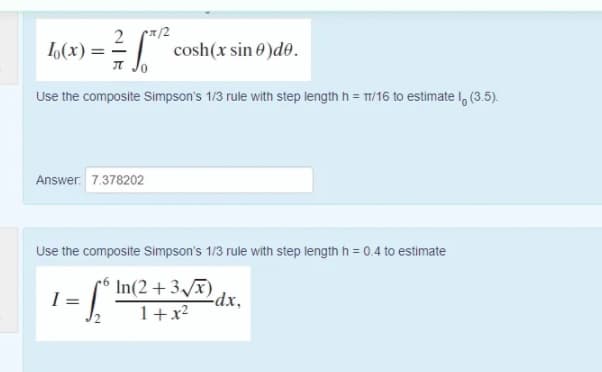Use the composite Simpson's 1/3 rule with step length h = 0.4 to estimate In(2 + 3/x) dx. 1+x² I =
Use the composite Simpson's 1/3 rule with step length h = 0.4 to estimate In(2 + 3/x) dx. 1+x² I =
Algebra & Trigonometry with Analytic Geometry
13th Edition
ISBN:9781133382119
Author:Swokowski
Publisher:Swokowski
Chapter3: Functions And Graphs
Section3.2: Graphs Of Equations
Problem 78E
Related questions
Question
Use composite simpsons rule
Answer problem # 2

Transcribed Image Text:/2
cosh(x sin 0 )de.
I Jo
2
L(x) = =
Use the composite Simpson's 1/3 rule with step length h = T/16 to estimate I, (3.5).
Answer. 7.378202
Use the composite Simpson's 1/3 rule with step length h = 0.4 to estimate
In(2 +3x)dx,
1+x2
I =
![Composite Simpson's rule [ edit ]
If the interval of integration [a, b) is in some sense "small", then Simpson's rule with n = 2 subintervals will provide an adequate approximation to the exact integral. By "small" we mean that the function being
integrated is relatively smooth over the interval [a, b]. For such a function, a smooth quadratic interpolant like the one used in Simpson's rule will give good results.
However, it is often the case that the function we are trying to integrate is not smooth over the interval. Typically, this means that either the function is highly oscillatory or lacks derivatives at certain points. In
these cases, Simpson's rule may give very poor results. One common way of handling this problem is by breaking up the interval [a, b] into n > 2 small subintervals. Simpson's rule is then applied to each
subinterval, with the results being summed to produce an approximation for the integral over the entire interval. This sort of approach is termed the composite Simpson's rule.
Suppose that the interval a, b is split up into n sub-intervals, with n an even number. Then, the composite Simpson's rule is given by
n/2
f(x) dx =
E [f(®2j_2) + 4f(x2j–1) + f(x2;)]
j=1
п/2-1
n/2
f(x0)+2 f(x2;) + 4 f(x2j–1) + f(xn)
3
j=1
j=1
where x; = a + jh for j = 0, 1,..., n – 1, n with h =
a)/n; in particular, xo = a and xn = b. This composite rule with n = 2 corresponds with the regular Simpson's Rule of the preceding section.
The error committed by the composite Simpson's rule is
h4
(b –
180
a) f(4) (£),
where { is some number between a and b, and h =
(b – a)/n is the "step length".3] The error is bounded (in absolute value) by
h4
()b
180
a) max |f(4 (£)|-
fe(a,b]
-](/v2/_next/image?url=https%3A%2F%2Fcontent.bartleby.com%2Fqna-images%2Fquestion%2F5ab465d2-ecd2-4cf7-b792-ba452fb913b9%2Fbc9910d4-472f-41e9-b794-7d3186a00773%2F82f6nvj_processed.jpeg&w=3840&q=75)
Transcribed Image Text:Composite Simpson's rule [ edit ]
If the interval of integration [a, b) is in some sense "small", then Simpson's rule with n = 2 subintervals will provide an adequate approximation to the exact integral. By "small" we mean that the function being
integrated is relatively smooth over the interval [a, b]. For such a function, a smooth quadratic interpolant like the one used in Simpson's rule will give good results.
However, it is often the case that the function we are trying to integrate is not smooth over the interval. Typically, this means that either the function is highly oscillatory or lacks derivatives at certain points. In
these cases, Simpson's rule may give very poor results. One common way of handling this problem is by breaking up the interval [a, b] into n > 2 small subintervals. Simpson's rule is then applied to each
subinterval, with the results being summed to produce an approximation for the integral over the entire interval. This sort of approach is termed the composite Simpson's rule.
Suppose that the interval a, b is split up into n sub-intervals, with n an even number. Then, the composite Simpson's rule is given by
n/2
f(x) dx =
E [f(®2j_2) + 4f(x2j–1) + f(x2;)]
j=1
п/2-1
n/2
f(x0)+2 f(x2;) + 4 f(x2j–1) + f(xn)
3
j=1
j=1
where x; = a + jh for j = 0, 1,..., n – 1, n with h =
a)/n; in particular, xo = a and xn = b. This composite rule with n = 2 corresponds with the regular Simpson's Rule of the preceding section.
The error committed by the composite Simpson's rule is
h4
(b –
180
a) f(4) (£),
where { is some number between a and b, and h =
(b – a)/n is the "step length".3] The error is bounded (in absolute value) by
h4
()b
180
a) max |f(4 (£)|-
fe(a,b]
-
Expert Solution
This question has been solved!
Explore an expertly crafted, step-by-step solution for a thorough understanding of key concepts.
Step by step
Solved in 3 steps with 3 images

Recommended textbooks for you

Algebra & Trigonometry with Analytic Geometry
Algebra
ISBN:
9781133382119
Author:
Swokowski
Publisher:
Cengage

Algebra & Trigonometry with Analytic Geometry
Algebra
ISBN:
9781133382119
Author:
Swokowski
Publisher:
Cengage